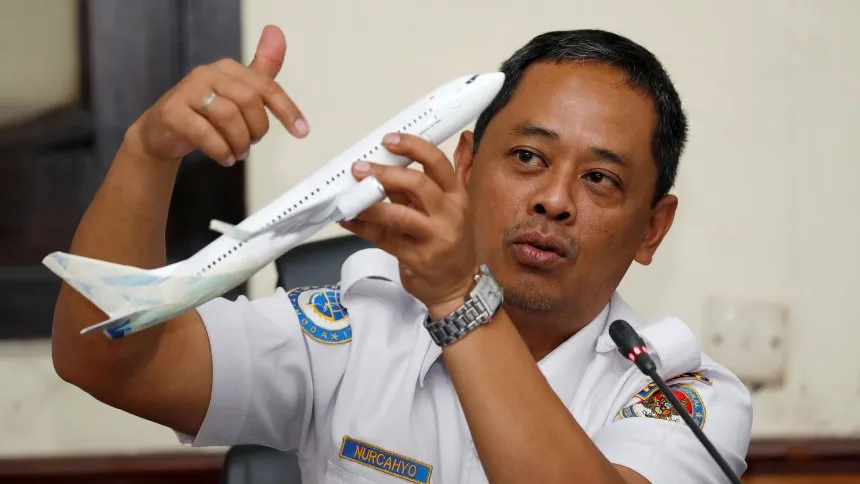Theo thông tin vừa công bố ngày 28/11, dữ liệu hộp đen của máy bay mang số hiệu JT 610 chở 189 người rơi xuống biển Java, Indonesia, tháng trước cho thấy, các phi công đã phải vật lộn với máy móc ngay từ lúc chiếc Boeing 737 này cất cánh bởi mũi máy bay liên tục chúc xuống do lỗi của thiết bị cảm ứng.
Ủy ban An toàn giao thông quốc gia Indonesia (KNKT) cũng cho biết hãng hàng không Lion Air đã tiếp tục khai thác chiếc máy bay này dù đã được báo cáo về lỗi hệ thống cảm ứng trên chuyến bay trước đó từ Denpasar, Bali đến Jakarta.
Ông Nurcahyo Utomo, phụ trách mảng hàng không tại KNKT trả lời với các phóng viên: "Trong chuyến bay trước chuyến bay gặp nạn, máy bay đã gặp vấn đề kỹ thuật nhưng phi công quyết định vẫn tiếp tục chuyến bay. Một vài quy trình khắc phục lỗi đã được áp dụng, tuy nhiên theo ý kiến của chúng tôi, chiếc máy bay này lẽ ra không được phép tiếp tục cất cánh."

Ông Nurcahyo Utomo, phụ trách hàng không Ủy ban An toàn giao thông Indonesia đang phân tích báo cáo sơ bộ về tai nạn máy bay Lion Air tại buổi họp báo ngày 28/11/2018 tổ chức tại Jakarta (Ảnh: Reuters)
Thông tin từ hộp đen của máy bay được công bố đã cho thấy các phi công đã "vật lộn liên tục đến phút cuối cùng", tìm cách nâng mũi của máy bay lên khoảng 20 lần chỉ trong 11 phút bay trước khi hoàn toàn mất kiểm soát và lao xuống biển.
Theo đó, hệ thống điều khiển bằng máy tính được hãng Boeing cài đặt trên thế hệ máy bay 737 mới nhất của họ nhằm ngăn ngừa tình trạng mũi máy bay nhô lên quá cao đã gặp sự cố. Do nhận được thông tin sai từ các cảm biến trên thân máy bay, hệ thống điều khiển này đã tự động kéo mũi máy bay chúc xuống.
Sau vụ tai nạn máy bay Lion Air, nhiều phi công đã bày tỏ quan ngại về việc họ không được thông tin đầy đủ về hệ thống mới ở trên và không biết họ sẽ phải xử lý như thế nào nếu tình huống khẩn cấp tương tự xảy ra.
Các nhà điều tra vẫn chưa tìm thấy chiếc hộp đen ghi âm buồng lái máy bay. Nếu có được dữ liệu này, các bước xử lý sự cố của hai phi công sẽ được sáng tỏ để xem họ đã tuân thủ đúng quy trình cần thiết hay chưa.
Trước đó, vào ngày 29/10, chuyến bay mang số hiệu JT610 của hãng hàng không giá rẻ Indonesia Lion Air khởi hành từ Jakarta đi Pangkal Pinang đã gặp nạn lao xuống biển Java chỉ vài phút sau khi cất cánh, khiến toàn bộ 189 người trên khoang thiệt mạng. Vụ tai nạn khiến cả thế giới quan tâm và là hồi chuông báo động về vấn đề an toàn hàng không, đặc biệt ở Indonesia - quốc gia tập trung nhiều hãng hàng không có hồ sơ an toàn bay thuộc loại kém trên thế giới.
Lion Air crash: Investigators say plane was 'not airworthy'
(BBC) - Indonesian investigators have said the Lion Air plane that crashed last month killing 189 people, was not airworthy and should have been grounded.
On 29 October a Boeing 737 Max plane crashed into the Java Sea shortly after departing Jakarta.
A preliminary report has found technical problems had been reported on previous flights.
The 737 Max is a new version of Boeing's original 737 and has become its the fastest selling plane.
The preliminary report details what is known by authorities about the short time the plane was in the air, but investigators said it does not give a definitive cause for the accident.
What's in the report?
The findings by the National Transport Safety Committee (KNKT) suggest that Lion Air put the plane back into service despite it having had problems on earlier flights.
It's second last flight was from Denpasar in Bali to Jakarta.
"During [that] flight, the plane was experiencing a technical problem but the pilot decided to continue," Nurcahyo Utomo, aviation head at the National Transport Safety Committee, told reporters.
The report outlines several maintenance procedures that were done in response to those problems, both prior to the aircraft's previous and its final flight.
"In our opinion, the plane was no longer airworthy and it should not have continued," he said. The committee report itself though does not spell out that conclusion.
The report also indicated that pilots struggled with the aircraft's anti-stall automated system, which was a new feature in the 737 Max family of aircraft.
The report says the airline should ensure the operations manual is followed "in order to improve the safety culture and to enable the pilot to make proper decision to continue the flight".
It also says the carrier must ensure "all operations documents are properly filled and documented".
How did the crash unfold?
The plane was making a one-hour journey to the western city of Pangkal Pinang when it went down.
The jet crashed following a request from the pilot for permission to turn back to the airport minutes after taking off from Jakarta.
Investigators had previously revealed that the plane, on previous flights, had experienced technical problems related to airspeed and altitude readings.
Therefore the "angle-of-attack" sensor, which contributes to those readings, had been changed the day before the crash.
However, media reports have suggested the sensor malfunctioned on the ill-fated flight as well, causing the anti-stall system to pitch the nose of the aircraft downwards.
It is unclear why the pilots did not employ procedures to disable the automated system.
One of the black box recorders from the flight - the flight data recorder- has been retrieved but authorities are yet to locate the cockpit voice recorder which could provide more information about how the pilots reacted.
Victims' families are suing aircraft maker Boeing over alleged faults with the jet's design, focussing on the automated safety feature.

